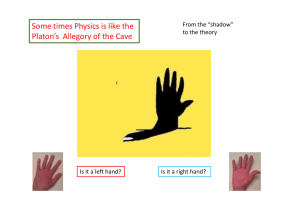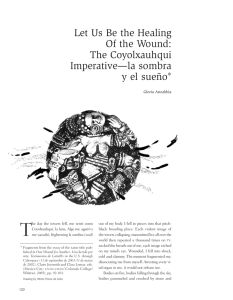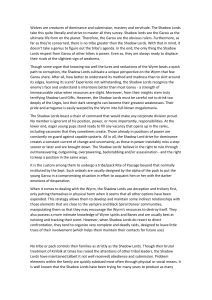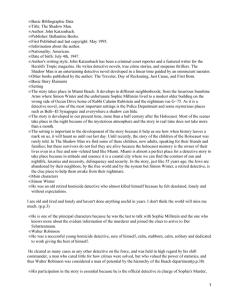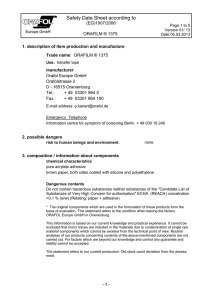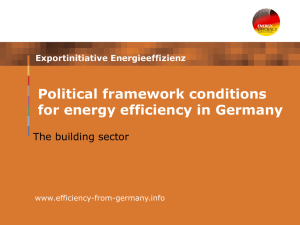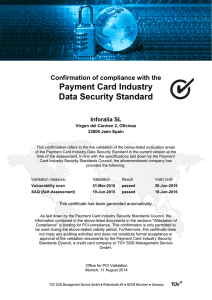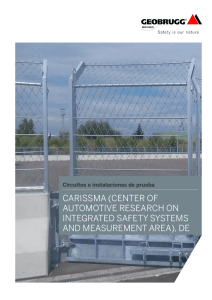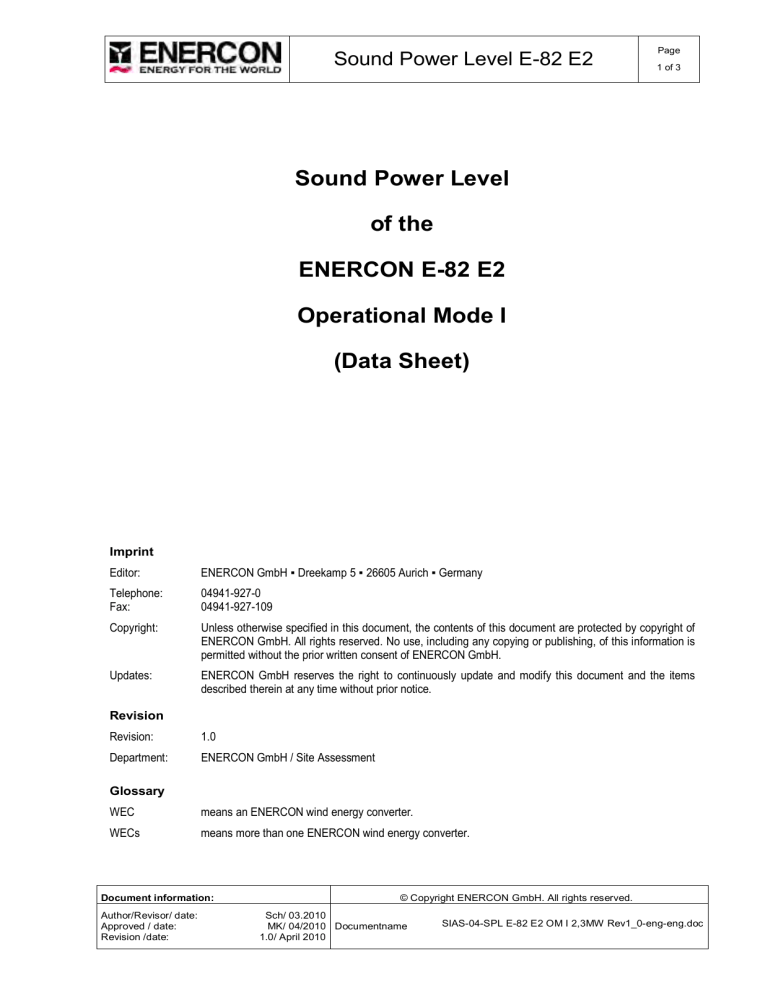
Sound Power Level E-82 E2 Page 1 of 3 Sound Power Level of the ENERCON E-82 E2 Operational Mode I (Data Sheet) Imprint Editor: ENERCON GmbH ▪ Dreekamp 5 ▪ 26605 Aurich ▪ Germany Telephone: Fax: 04941-927-0 04941-927-109 Copyright: Unless otherwise specified in this document, the contents of this document are protected by copyright of ENERCON GmbH. All rights reserved. No use, including any copying or publishing, of this information is permitted without the prior written consent of ENERCON GmbH. Updates: ENERCON GmbH reserves the right to continuously update and modify this document and the items described therein at any time without prior notice. Revision Revision: 1.0 Department: ENERCON GmbH / Site Assessment Glossary WEC means an ENERCON wind energy converter. WECs means more than one ENERCON wind energy converter. Document information: Author/Revisor/ date: Approved / date: Revision /date: © Copyright ENERCON GmbH. All rights reserved. Sch/ 03.2010 MK/ 04/2010 Documentname 1.0/ April 2010 SIAS-04-SPL E-82 E2 OM I 2,3MW Rev1_0-eng-eng.doc Page Sound Power Level E-82 E2 2 of 3 Sound Power Level for the E-82 E2 with 2300 kW rated power in relation to wind speed at 10 m height hub height 78 m 85 m 98 m 108 m 138 m 5 m/s 96,3 dB(A) 96.6 dB(A) 97.2 dB(A) 97.5 dB(A) 98.2 dB(A) 6 m/s 100.7 dB(A) 101.0 dB(A) 101.6 dB(A) 101.9 dB(A) 102.6 dB(A) 7 m/s 103.3 dB(A) 103.5 dB(A) 103.6 dB(A) 103.6 dB(A) 103.8 dB(A) 8 m/s 104.0 dB(A) 104.0 dB(A) 104.0 dB(A) 104.0 dB(A) 104.0 dB(A) 9 m/s 104.0 dB(A) 104.0 dB(A) 104.0 dB(A) 104.0 dB(A) 104.0 dB(A) 10 m/s 104.0 dB(A) 104.0 dB(A) 104.0 dB(A) 104.0 dB(A) 104.0 dB(A) 95% rated power 104.0 dB(A) 104.0 dB(A) 104.0 dB(A) 104.0 dB(A) 104.0 dB(A) Vs in 10 m height Measured value at 95% rated power 103,4 dB(A) KCE 209244-03.03 in relation to wind speed in hub height wind speed at hub height [m/s] 7 8 9 10 11 12 13 14 15 Sound Power Level [dB(A)] 96.6 99.9 102.6 103.5 104.0 104.0 104.0 104.0 104.0 1. The relation between the sound power level and the standardized wind speed in 10 m height as shown above is valid on the premise of a logarithmic wind profile with a roughness length of 0.05 m. The relation between the sound power level and the wind speed at hub height applies for all hub heights. During the sound measurements the wind speeds are derived from the power output and the power curve of the WEC. 2. A tonal audibility of ΔLa,k ≤ 2 dB can be expected over the whole operational range (valid in the near vicinity of the turbine according to IEC 61 400 -11 ed. 2). 3. The sound power level values given in the table are valid for the Operational Mode I (defined via the rotational speed range of 6 – 18 rpm). The respective power curve is the calculated power curve E-82 E2 dated November 2009 (Rev. 3.x). 4. The values displayed in the tables above are based on official and internal measurements of the sound power level. If available the official measured values are given in this document as a Document information: Author/Revisor/ date: Approved / date: Revision /date: © Copyright ENERCON GmbH. All rights reserved. Sch/ 03.2010 MK/ 04/2010 Documentname 1.0/ April 2010 SIAS-04-SPL E-82 E2 OM I 2,3MW Rev1_0-eng-eng.doc Sound Power Level E-82 E2 Page 3 of 3 reference (in italic print). The extracts of the official measurements can be made available upon request. The values given in the measurement extracts do not replace the values given in this document. All measurements have been carried out according to the recommended German and international standards and guidelines as defined in the measurement reports, respectively. 5. Due to the typical measurement uncertainties, if the sound power level is measured according to one of the accepted methods the measured values can differ from the values shown in this document in the range of +/- 1 dB. Accepted measurement methods are: a) IEC 61400-11 ed. 2 („Wind turbine generator systems – Part 11: Acoustic noise measurement techniques; Second edition, 2002-12“), and b) the FGW-Guidelines („Technische Richtlinie für Windenergieanlagen – Teil 1: Bestimmung der Schallemissionswerte“, published by the association “Fördergesellschaft für Windenergie e.V.”, 18th revision). If the difference between total noise and background noise during a measurement is less than 6 dB a higher uncertainty must be considered. 6. For noise-sensitive sites it is possible to operate the E-82 E2 with reduced rotational speed and reduced rated power during night time. The sound power levels resulting from such operational mode can be provided in a separate document upon request. 7. The sound power level of a wind turbine depends on several factors such as but not limited to regular maintenance and day-to-day operation in compliance with the manufacturer’s operating instructions. Therefore, this data sheet can not, and is not intended to, constitute an express or implied warranty towards the customer that the E-82 E2 WEC will meet the exact sound power level values as shown in this document at any project specific site. Document information: Author/Revisor/ date: Approved / date: Revision /date: © Copyright ENERCON GmbH. All rights reserved. Sch/ 03.2010 MK/ 04/2010 Documentname 1.0/ April 2010 SIAS-04-SPL E-82 E2 OM I 2,3MW Rev1_0-eng-eng.doc Sound Power Level E-82 E2 Page 1 of 3 Sound Power Level of the ENERCON E-82 E2 Operational Mode 2000 kW (Data Sheet) Imprint Editor: ENERCON GmbH ▪ Dreekamp 5 ▪ 26605 Aurich ▪ Germany Telephone: Fax: 04941-927-0 04941-927-109 Copyright: Unless otherwise specified in this document, the contents of this document are protected by copyright of ENERCON GmbH. All rights reserved. No use, including any copying or publishing, of this information is permitted without the prior written consent of ENERCON GmbH. Updates: ENERCON GmbH reserves the right to continuously update and modify this document and the items described therein at any time without prior notice. Revision Revision: 1.0 Department: ENERCON GmbH / Site Assessment Glossary WEC means an ENERCON wind energy converter. WECs means more than one ENERCON wind energy converter. Document information: Author/Revisor/ date: Approved / date: Revision /date: © Copyright ENERCON GmbH. All rights reserved. Sch/ 03.2010 MK/ 04/ 2010 Documentname 1.0/ April 2010 SIAS-04-SPL E-82 E2 2MW Rev1_0-eng-eng.doc Page Sound Power Level E-82 E2 2 of 3 Sound Power Level for the E-82 E2 with 2000 kW rated power in relation to wind speed at 10 m height hub height 78 m 85 m 98 m 108 m 138 m 5 m/s 96,3 dB(A) 96.6 dB(A) 97.2 dB(A) 97.5 dB(A) 98.2 dB(A) 6 m/s 100.7 dB(A) 101.0 dB(A) 101.6 dB(A) 101.9 dB(A) 102.6 dB(A) 7 m/s 103.3 dB(A) 103.5 dB(A) 103,5 dB(A) 103,5 dB(A) 103,5 dB(A) 8 m/s 103,5 dB(A) 103,5 dB(A) 103,5 dB(A) 103,5 dB(A) 103,5 dB(A) 9 m/s 103,5 dB(A) 103,5 dB(A) 103,5 dB(A) 103,5 dB(A) 103,5 dB(A) 10 m/s 103,5 dB(A) 103,5 dB(A) 103,5 dB(A) 103,5 dB(A) 103,5 dB(A) 95% rated power 103,5 dB(A) 103,5 dB(A) 103,5 dB(A) 103,5 dB(A) 103,5 dB(A) Vs in 10 m height Measured value at 95% rated power 102,5 dB(A) KCE 209244-03.04 in relation to wind speed in hub height wind speed at hub height [m/s] 7 8 9 10 11 12 13 14 15 Sound Power Level [dB(A)] 96.6 99.9 102.6 103.5 103.5 103.5 103.5 103.5 103.5 1. The relation between the sound power level and the standardized wind speed in 10 m height as shown above is valid on the premise of a logarithmic wind profile with a roughness length of 0.05 m. The relation between the sound power level and the wind speed at hub height applies for all hub heights. During the sound measurements the wind speeds are derived from the power output and the power curve of the WEC. 2. A tonal audibility of ΔLa,k ≤ 2 dB can be expected over the whole operational range (valid in the near vicinity of the turbine according to IEC 61 400 -11 ed. 2). 3. The sound power level values given in the table are valid for the Operational Mode 2000 kW (defined via the rotational speed range of 6 – 17,5 rpm). The respective power curve is the calculated power curve E-82 E2 2MW dated November 2009 (Rev. 3.x). 4. The values displayed in the tables above are based on official and internal measurements of the sound power level. If available the official measured values are given in this document as a Document information: Author/Revisor/ date: Approved / date: Revision /date: © Copyright ENERCON GmbH. All rights reserved. Sch/ 03.2010 MK/ 04/ 2010 Documentname 1.0/ April 2010 SIAS-04-SPL E-82 E2 2MW Rev1_0-eng-eng.doc Sound Power Level E-82 E2 Page 3 of 3 reference (in italic print). The extracts of the official measurements can be made available upon request. The values given in the measurement extracts do not replace the values given in this document. All measurements have been carried out according to the recommended German and international standards and guidelines as defined in the measurement reports, respectively. 5. Due to the typical measurement uncertainties, if the sound power level is measured according to one of the accepted methods the measured values can differ from the values shown in this document in the range of +/- 1 dB. Accepted measurement methods are: a) IEC 61400-11 ed. 2 („Wind turbine generator systems – Part 11: Acoustic noise measurement techniques; Second edition, 2002-12“), and b) the FGW-Guidelines („Technische Richtlinie für Windenergieanlagen – Teil 1: Bestimmung der Schallemissionswerte“, published by the association “Fördergesellschaft für Windenergie e.V.”, 18th revision). If the difference between total noise and background noise during a measurement is less than 6 dB a higher uncertainty must be considered. 6. For noise-sensitive sites it is possible to operate the E-82 E2 with reduced rotational speed and reduced rated power during night time. The sound power levels resulting from such operational mode can be provided in a separate document upon request. 7. The sound power level of a wind turbine depends on several factors such as but not limited to regular maintenance and day-to-day operation in compliance with the manufacturer’s operating instructions. Therefore, this data sheet can not, and is not intended to, constitute an express or implied warranty towards the customer that the E-82 E2 WEC will meet the exact sound power level values as shown in this document at any project specific site. Document information: Author/Revisor/ date: Approved / date: Revision /date: © Copyright ENERCON GmbH. All rights reserved. Sch/ 03.2010 MK/ 04/ 2010 Documentname 1.0/ April 2010 SIAS-04-SPL E-82 E2 2MW Rev1_0-eng-eng.doc Technical information Page Shadow shut-off 1 of 3 Shutdown system for limiting periodic shadow casting (Shadow Shut-Off) 1. General information Periodic shadow casting (or shadow flickering) is caused by movement of the rotor blades, which chop the sunlight and create a flickering effect whilst the rotor is in motion. The occurrence of this effect depends on the current local weather conditions, the wind direction, the altitude of the sun, and the wind energy converter (WEC) operating hours. Periodic shadow casting should not be confused with periodic reflexion of the sunlight on the rotor blades, also referred to as the “disco effect.” In recent years, the use of suitable paint/colours has reduced this flashing effect. The goal of shadow shut-off is to reliably prevent or reduce shadow flickering in relevant locations where this type of immission could be annoying (e.g. living rooms, bedrooms, schools, patios, etc.). To prevent or reduce this type of immission, ENERCON has developed a shadow shut-off system for its wind energy converters that enables targeted shutdown of WECs, taking into account the meteorological conditions. 2. Shadow shut-off operating principle Shadow shut-off is a program that is integrated into the WEC’s control system. Shut-off is WEC-specific, i.e., the program is installed in WECs where shadow shut-off is required. Shadow shut-off can be programmed and shadow shut-off parameters can be set on the WEC display where other WEC parameters are set and operating data can be retrieved. 2.1 Determining shadow shut-off times The ENERCON shadow shut-off system is a calendrical system, i.e., shut-off times are programmed as a calendar. The times of the maximum astronomical shadow casting potential (“worst case”) at affected immission sites are computed considering site-specific parameters (hub height, rotor diameter, WEC coordinates, location of the immission site, topography). Results include the shadow casting periods at relevant immission sites, indicating daily start and end times of periodic shadow casting. The shut-off times determined are programmed into the WEC control system as a table. Finetuning of these time specifications is feasible at any time for each immission site and time period. 2.2 Measuring illuminance Actual shadow flickering by movement of the WEC rotor blades chiefly depends on insolation. According to the German Federal States’ Immission Control Committee (Länderausschuss für Immissionsschutz), shadow flickering is likely Document information: Author/date: Department: Approved/date: WdB / 2003-04-29 Translator/date: St / 2010-06-07 Revisor/date: WRD / SiAs Ge / 2010-06-11 Reference: © Copyright ENERCON GmbH. All rights reserved. Stefan Wenderoth / 2008-07-02 SiAs-SH-Information Schattenabschaltung-Rev1.5-ger-eng Technical information Page Shadow shut-off 2 of 3 when the sunlight is greater than 120 W/m² at the level vertical to the incidence direction. The level of illuminance E [lx] on a horizontal measuring surface is influenced by the incidence angle of the sun (altitude of the sun) and the photometric equivalent that is determined by refraction, atmospheric opacity, and the position of the sun, too. Because the illuminance depending on the altitude of the sun can therefore only be approximated, and because the actual altitude of the sun is unknown to the WEC control system, a procedure has been developed to exactly assess the occurrence of shadow casting at any time. To measure illuminance, three sensors are fitted to the WEC tower at a height of three to four metres and spaced at 120° angles. This arrangement ensures that at least one sensor is always on the sunny side and one in the shade of the tower. Based on the measured values from the three sensors, the control system determines the highest illuminance value, also referred to as light intensity, and the lowest illuminance value, referred to as shadow intensity. The ratio of shadow and light intensity – also referred to as shut-off intensity – and not the common but inherently inaccurate measuring of illuminance is used to determine whether shadow casting must be expected. With an illuminance of 120 W/m², the measured shut-off intensity is 36%. This value is virtually independent of the altitude of the sun. Once the ratio between shadow and light intensity drops below 36%, illuminance is greater than 120 W/m² and shadow casting occurs. This value has been validated in the setting of a twoyear field test of shadow shut-off modules. Shut-off intensity can be modified individually as needed. 2.3 Automatic Shutdown Shadow shut-off is activated, i.e., the wind energy converter is shut down once the ratio between shadow and light intensity falls below the set value inside the programmed shut-off time frame. No average is computed for the measured illuminance. Automatic shutdown will therefore respond even if the value falls below the reference value only briefly. If the light conditions are such that shadow flickering is no longer possible, shadow shut-off will remain active initially and the WEC will remain at a standstill. Shadow shut-off will not be deactivated unless light conditions have not changed for a specified period of time (as a rule, 5 minutes) and shadow flickering has not been possible during that period. Shadow shut-off will also be deactivated on leaving the shut-off time frame. 3. Data logging Activation of the shadow shut-off system is recorded as a status message by the remote monitoring system together with its date, time and duration and is then stored for several years. Document information: Author/date: Department: Approved/date: WdB / 2003-04-29 Translator/date: St / 2010-06-07 Revisor/date: WRD / SiAs Ge / 2010-06-11 Reference: © Copyright ENERCON GmbH. All rights reserved. Stefan Wenderoth / 2008-07-02 SiAs-SH-Information Schattenabschaltung-Rev1.5-ger-eng Technical information Page Shadow shut-off 3 of 3 As a rule, measured light and shadow intensities are not yet logged due to the large data volume. 4. Tolerances / reliability The sensor used for measuring illuminance has a typical tolerance of ± 10%. Following inspection of the sensors, a set of three sensors with a maximum tolerance of ± 1% towards one another is selected at the factory within the framework of the QA process. As no absolute measured values but only the ratio of the illuminance values is important for signal interpretation, a very high degree of accuracy is achieved. In addition, the function of the light sensors is automatically checked for plausibility twice daily during operation. This involves measurement of the voltages at the three light sensors at midnight and at 1:00 p.m. In the event of implausible values a warning message is sent to ENERCON Service. Technicians will check the sensors on site and replace them, if necessary. Failure of a sensor (e.g. due to a broken cable or a short circuit) always results in shutdown of the wind energy converter inside the programmed time frames, since the ratio between the light and shadow intensities falls below the shut-off intensity value. 5. Applicability The shadow shut-off system is currently available for ENERCON WECs of the E-30/3.30, E-40/6.44, E-58/10.58, E-66/18.70 and E-66/20.70 types as well as for the new turbine generations: E-33, E-44, E-48, E-53, E-70 E4, E-82, E-82 E2, E-82 E3, E-101, E-112, and E-126. The shadow shut-off system does not depend on the hub height, rotor diameter, or tower type. Document information: Author/date: Department: Approved/date: WdB / 2003-04-29 Translator/date: St / 2010-06-07 Revisor/date: WRD / SiAs Ge / 2010-06-11 Reference: © Copyright ENERCON GmbH. All rights reserved. Stefan Wenderoth / 2008-07-02 SiAs-SH-Information Schattenabschaltung-Rev1.5-ger-eng
